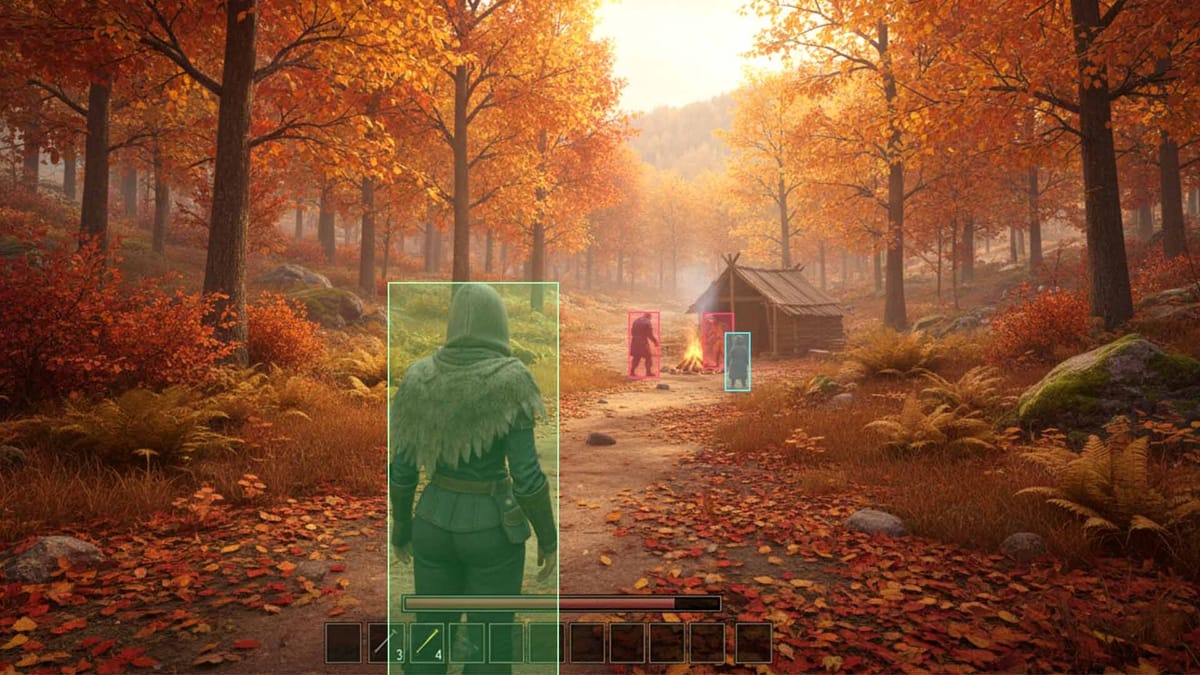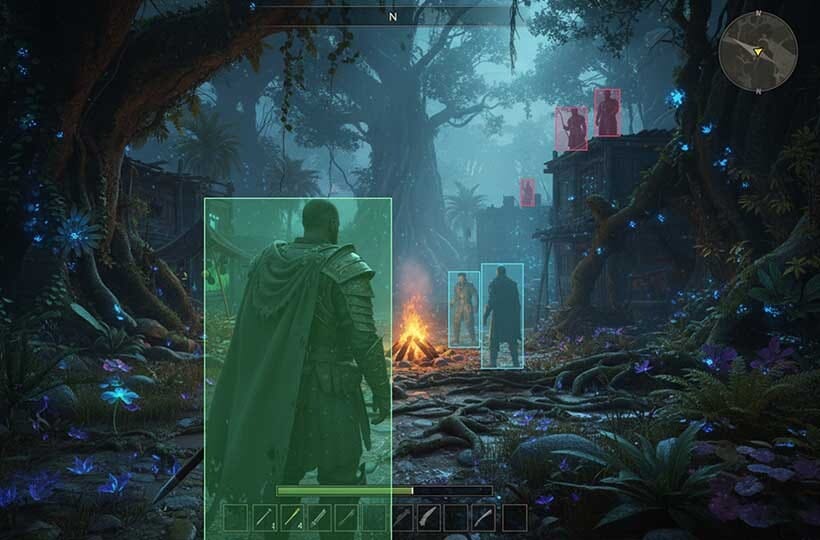Data Annotation for AI NPC Behavior & Pathfinding

Modern games are undergoing a real revolution thanks to AI - especially in how non-player characters (NPCs) are created, react, and evolve, as well as how their behavior and navigation in space are built.
NPC behavior is based on prescribed scripts: the character patrols a specific route, responds to triggers, and performs predetermined actions. Now, with the advent of machine learning and neural models, NPCs have become dynamic - they can adapt to the player's actions and even show personality.
Such models cannot exist without large-scale data annotation. People create example scenarios, label types of behavior, and typical movement patterns - that is, provide training examples for algorithms.
Key Takeaways
- Modern character behavior systems require millions of contextual data labels.
- Reinforcement learning tools transform static code into adaptive responses.
- Human-verified annotations ensure nuanced environmental understanding.
- Multi-layered tagging improves collision detection and route optimization.
- Consistent labeling standards enable cross-platform behavioral consistency.

Historic Milestones in Development
The first notable use of AI in games was the emergence of finite state machines in early arcade and strategy games of the 1980s and 1990s. At that time, NPCs could not learn or adapt - clear states and transitions between them shaped their behavior. For example, an enemy could be in a state of "patrol", "attack", or "retreat", and the change of state occurs only under certain conditions programmed by the developers. This allowed for the creation of the illusion of an "intelligent" enemy, although in reality, everything was predictable.
Only in 2019, thanks to the appearance of OpenAI Five, AI learned to play Dota 2, using data on reinforcements, observing its own actions, and match results. The agent did not have pre-written strategies - it learned through experiments, gradually discovering optimal solutions.
A few years later, The Last of Us Part II was released, demonstrating how map grids and behavioral models can create a sense of realism. The NPCs in that game employed adaptive navigation, understood cover, coordinated actions within teams, and responded to the deaths of allies. All of this created a sense of realism and emotional presence, as enemy behavior seemed genuinely real.
Modern Neural Networks and Dynamic Environments
Modern neural networks enable NPCs to predict the development of events by analyzing past patterns of behavior from the player and other agents, and to make choices that appear strategic for the character. The networks work with reinforcement data, trying different actions, evaluating the results, and gradually selecting the optimal strategies.
An example of such an approach is S.T.A.L.K.E.R. 2: Heart of Chornobyl, where the A-Life system is implemented - a system designed to simulate the life of the Zone. Groups and mutants fight for living space, migrate, seize new places, or retreat, under pressure from opponents, to safer positions, even when the player does not see it. Their behavior takes into account tactics, cover, and interaction between factions, and the emotional behavior system enables to create a sense of a "living world". Despite the initial problems, the latest patches have already improved the behavior of AI and NPC interaction. A-Life brings the Zone to life, making it truly alive and unpredictable, offering a unique gaming experience.
Best Practices for Game AI Annotation
- Clearly define data types and labels. Before beginning annotation, it is necessary to determine precisely what should be labeled, such as NPC behavior, navigation paths, emotional reactions, and interaction zones. Using key categories, like state machines or emotion tagging, helps ensure the consistency and accuracy of the data.
- Use realistic scenarios. Annotations should be based on scenarios that closely resemble how a player will interact with an NPC. This includes dynamic environmental changes, unpredictable player actions, and complex conflict situations.
- Spatial data labeling. Using map grids or other geometric structures to indicate routes, obstacles, visibility zones, and cover provides an accurate basis for training pathfinding models.
- Use reinforcement data. When annotating, it is helpful to consider the potential consequences of NPC actions to offer data to reinforcement learning. This allows agents to be trained on optimal strategies in complex situations.
- Consistency and standardization. It is essential to establish annotation standards, including consistent file formats, naming conventions, and labeling methods, to ensure accurate and reliable annotation. This helps reduce errors and improve data quality as the project scales.
- Validation and quality control. A regular QA process ensures that annotations are correct and reproducible. This includes verifying NPC routes, behavior logic, and ensuring that emotional tags align with the scene context.
- Iteratively update data. The game world changes, and NPCs may receive new scenarios. Annotation data should be updated and expanded as the game mechanics and design change.
- Document the process. Maintaining documentation of annotation methods, labeling examples, and team guidelines facilitates the training of new annotators and ensures data consistency across large-scale projects.

Establishing Clear Annotation Guidelines
Establish data formats and standards, including file types, naming conventions, and rules for designating coordinates, zones, or NPC actions. This simplifies the processing and integration of annotations into neural networks and other AI systems.
A regular QA process for annotations should be implemented, allowing inaccuracies, inconsistencies, or missing data to be detected before training is conducted. Reasonable quality control creates the foundation for scalable and efficient training of game AI, allowing NPCs to behave naturally and adaptively.
Training and Empowering Annotation Teams
- Develop labeling categories and rules. Each data type should be described: what is considered correct labeling, examples of correct and incorrect labels, label types, file formats, and ways to label zones or NPC states. It is recommended to use graphic examples, screenshots, or short videos to clarify the material.
- Define the sequence and standards of the process. The instructions should clearly explain the order in which the steps are performed, how one’s work should be verified, and what actions to take in complex or ambiguous cases.
- Launch the pilot. Annotators should undergo training in which they perform test annotations according to the instructions, receive feedback, and improve their skills. This helps to achieve a single level of understanding and consistency among the entire team.
Enhancing NPC Behavior
New approaches are constantly emerging to improve NPC behavior. Hierarchical behavioral models - instead of a single-level logic where the NPC chooses between individual actions, a structure with several levels is used: the top level defines the goal (for example, "protect the territory"), the middle level - tactics (choose cover, call allies), and the bottom level - specific actions (steps, aiming, movement).
This also includes social behavior models. NPCs can take into account the behavior of other characters or even adjust their actions based on the "social context". For example, a group of NPCs can change patrols if they see a player, or react to a conflict between other NPCs.
Another concept is the integration of uncertainty and randomness. Even under the same conditions, NPCs can make different decisions, and this makes their behavior less predictable. Probabilistic models or stochastic states are used, which allows NPCs to look more alive and unique in each case.
Leveraging Real-Time Data Processing
- Streaming data sources. NPCs receive information from all subsystems of the game, including the player's position and other NPCs, objects in their vicinity, physical interactions, lighting, sounds, environmental events, and random factors.
- Fast initial analysis. The system filters out unimportant signals and identifies critical threats and opportunities. At this stage, the NPC makes instant decisions: dodge, hide, attack, or flee.
- Deep contextual analysis. In parallel, more detailed data processing is launched, including predicting the player's actions, assessing the behavior of allies and enemies, calculating optimal routes, and facilitating strategic coordination among NPCs.
- Integration of decisions. The results of both levels of analysis are combined: the NPC simultaneously reacts to urgent threats and builds a strategic plan of action, adapting to changes in the world.
- Updating the state of the NPC in the game. Behavior is updated in real-time: changes in position, health, internal goals, emotional reactions, and interaction with other agents.
Tools and Technologies for Effective Data Annotation
Challenges in Game Development, Data Annotation, and How to Overcome Them
- Large data volume - automate some annotations using scripts and special tools, combined with manual verification.
- Complexity of 3D scenes and navigation - use cuboid, point cloud, and 3D annotation editors with visual verification.
- Annotator inconsistency - create clear instructions, standards, and examples, and conduct regular quality control.
- Game world dynamics - use timeline segments, data streaming, and video annotation tools.
- Emotional and social aspects of NPCs - use categorical tags, continuous scales, proximity graphs, and multi-level verification by experts.
- Errors in large projects - implement automatic checks, control datasets, and regular QA with iterative annotation updates.
- Time and resource constraints - break projects into modules, prioritize key scenarios, and apply semi-supervised or active learning to optimize the process.
Summary
The development of AI in games has gone from the first state machines, where NPCs acted according to clear scenarios, to modern neural systems that can adapt to a dynamic world.
The real power of modern AI lies in its ability to process data in real-time, respond quickly to changes in the environment, and plan strategic actions based on context. Hierarchical behavior patterns, context prediction, social interaction, and the integration of uncertainty make NPCs alive, unpredictable, and "thinking" agents in the game world.
In the future, AI in game development will further integrate adaptive NPC systems, social behavior, and the modeling of complex scenarios, creating a world that feels alive even without the player's presence. Real-time development, action prediction, and emotional integration are key factors that make modern game worlds rich and dynamic.
FAQ
What was the first application of AI in games?
Early games utilized state machines to control NPC behavior, where characters transitioned between predefined states, such as "patrolling" or "attacking." It was predictable but created the illusion of intelligence.
How did OpenAI Five change AI in gaming?
OpenAI Five utilized reinforcement learning data to develop strategies in Dota 2, demonstrating that AI can make adaptive and strategic decisions in complex, dynamic environments.
What role do map grids play in game AI?
Map grids enable NPCs to navigate 2D or 3D worlds efficiently, plan routes, avoid obstacles, and adapt to environmental changes in real-time.
Why is emotion tagging important for NPC behavior?
Emotion tagging enables NPCs to react according to their emotional context - fear, aggression, or curiosity - making their responses feel natural and dynamic.
What is the benefit of hierarchical behavior models for NPCs?
Hierarchical models break decisions into goal, strategy, and action layers, enabling NPCs to act flexibly, plan strategically, and coordinate with other agents.
How does real-time data processing enhance NPC intelligence?
By analyzing environmental signals, player actions, and NPC states in real time, AI can make immediate reactions while simultaneously planning long-term strategies.
What types of annotations are commonly used in game AI?
Common types include state annotations, spatial annotations (such as bounding box, cuboid, and point cloud), action labels, emotion tagging, and social/interaction tags for group behavior.
What are common challenges in game data annotation?
Challenges include large volumes of data, 3D scene complexity, inconsistent annotations, dynamic environments, and accurately capturing emotional or social behavior. Solutions involve clear guidelines, QA, modular workflows, and semi-automated tools.
How did S.T.A.L.K.E.R. 2 implement AI for NPCs?
S.T.A.L.K.E.R. 2 utilizes dynamic map grids and probabilistic behavior models, enabling NPCs to patrol, hunt, and interact with the environment adaptively, responding to player actions and environmental hazards.
What is the future direction of AI in games?
AI will focus on adaptive NPCs, real-time prediction, social interactions, and emotional intelligence, creating worlds where NPCs feel autonomous, dynamic, and alive even without player input.

